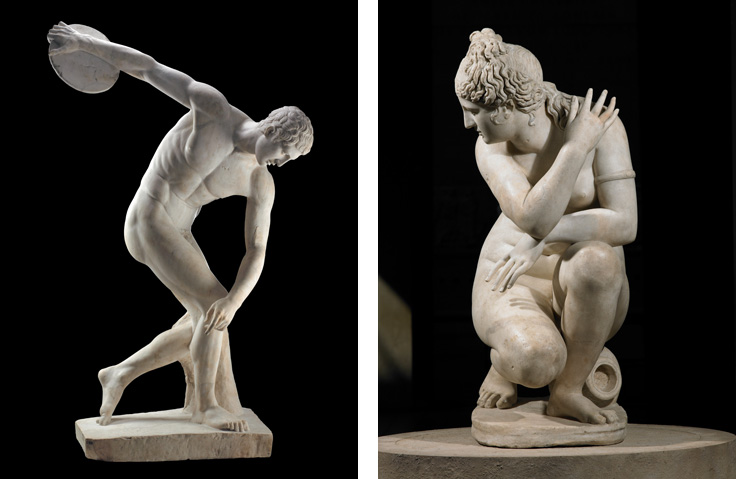Giacobbe Giusti, Classical Sculpture

- Antiquities
- |
- Art News & Reviews
- |
- March 24, 2015
Classical Sculpture: The body beautiful
Classical sculpture is the focus of a series of exhibitions this spring, one of them at the new Rem Koolhaas-designed Fondazione Prada in Milan. Claire Wrathall reports
‘This is the body people want to have,’ said Neil MacGregor, director of the British Museum, of the Belvedere Torso, the powerfully muscled trunk and thighs carved from marble during the first century B.C. and signed by the Athenian sculptor Apollonios. He was speaking at the launch of Defining Beauty: The Body in Ancient Greek Art (26 March– 5 July), one of several major surveys of classical sculpture opening this spring. This, the work on which Michelangelo based his depiction of Adam on the Sistine Chapel ceiling and which usually resides in the Vatican, will be a highlight.

In these body-conscious times, perhaps it’s not so surprising that a fashion brand would want to launch the new HQ of its arts foundation with a celebration of classical statuary. Hence Miuccia Prada’s decision to open the new Fondazione Prada — Rem Koolhaas’s radical reinvention of a derelict, century-old distillery in Milan’s Largo Isarco — with Serial Classic (9 May–24 August). The show, curated by the distinguished archaeologist Salvatore Settis, explores ideas of imitation, multiples and editioning in Greek and Roman sculpture.
So committed to the idea of celebrating antiquity is Prada that it is staging a second, concurrent show, Portable Classic (9 May–13 September), at Ca’ Corner della Regina in Venice, which will explore miniaturisation and portability through 90 artworks. It, too, will feature versions of the Belvedere Torso: a 16th- century bronze just 20cm tall from the Bargello Museum, and a 19th-century plaster cast from the Museum of Classical Art at the Sapienza University of Rome, which is approximately the size of the original, a monumental 1.59m high.


As the Vatican’s catalogue points out, the work — currently thought to depict Ajax as he contemplates suicide — was probably inspired by a bronze from the first half of the second century B.C. According to Jens Daehner and Kenneth Lapatin of the J Paul Getty Museum in Los Angeles, the curators of Power and Pathos: Bronze Sculpture of the Hellenistic World at Palazzo Strozzi in Florence (Until 21 June), this medium ‘allowed artists to impart an unprecedented level of dynamism to their full-figure statues and of naturalism to their portraits, where psychological expression became a hallmark of the style’.


One can only wonder at how expressive the original bronze sculpture might have been, although even in marble and without its head, the Vatican Torso communicates extraordinary tension and strength, even anguish. As Michelangelo wrote of it: ‘This is the work of a man who knew more than nature.’
Belevedere Torso. Photograph © 2015 Scala, Florence
For more features, interviews and videos, see our Art Digest homepage
Classical Sculpture: The body beautiful
Classical sculpture is the focus of a series of exhibitions this spring, one of them at the new Rem Koolhaas-designed Fondazione Prada in Milan. Claire Wrathall reports
‘This is the body people want to have,’ said Neil MacGregor, director of the British Museum, of the Belvedere Torso, the powerfully muscled trunk and thighs carved from marble during the first century B.C. and signed by the Athenian sculptor Apollonios. He was speaking at the launch of Defining Beauty: The Body in Ancient Greek Art (26 March– 5 July), one of several major surveys of classical sculpture opening this spring. This, the work on which Michelangelo based his depiction of Adam on the Sistine Chapel ceiling and which usually resides in the Vatican, will be a highlight.

In these body-conscious times, perhaps it’s not so surprising that a fashion brand would want to launch the new HQ of its arts foundation with a celebration of classical statuary. Hence Miuccia Prada’s decision to open the new Fondazione Prada — Rem Koolhaas’s radical reinvention of a derelict, century-old distillery in Milan’s Largo Isarco — with Serial Classic (9 May–24 August). The show, curated by the distinguished archaeologist Salvatore Settis, explores ideas of imitation, multiples and editioning in Greek and Roman sculpture.
So committed to the idea of celebrating antiquity is Prada that it is staging a second, concurrent show, Portable Classic (9 May–13 September), at Ca’ Corner della Regina in Venice, which will explore miniaturisation and portability through 90 artworks. It, too, will feature versions of the Belvedere Torso: a 16th- century bronze just 20cm tall from the Bargello Museum, and a 19th-century plaster cast from the Museum of Classical Art at the Sapienza University of Rome, which is approximately the size of the original, a monumental 1.59m high.


As the Vatican’s catalogue points out, the work — currently thought to depict Ajax as he contemplates suicide — was probably inspired by a bronze from the first half of the second century B.C. According to Jens Daehner and Kenneth Lapatin of the J Paul Getty Museum in Los Angeles, the curators of Power and Pathos: Bronze Sculpture of the Hellenistic World at Palazzo Strozzi in Florence (Until 21 June), this medium ‘allowed artists to impart an unprecedented level of dynamism to their full-figure statues and of naturalism to their portraits, where psychological expression became a hallmark of the style’.


One can only wonder at how expressive the original bronze sculpture might have been, although even in marble and without its head, the Vatican Torso communicates extraordinary tension and strength, even anguish. As Michelangelo wrote of it: ‘This is the work of a man who knew more than nature.’
Belevedere Torso. Photograph © 2015 Scala, Florence
For more features, interviews and videos, see our Art Digest homepage
Recommended
<div style=”display:inline;”> <img height=”1″ width=”1″ style=”border-style:none;” alt=”” src=”http://googleads.g.doubleclick.net/pagead/viewthroughconversion/1004977320/?value=0&label=3UvnCPii8QMQqPma3wM&guid=ON&script=0″/> </div> http://www.christies.com/features/Body-Beautiful-5723-1.aspx









